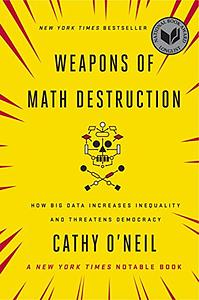Take a photo of a barcode or cover
challenging
informative
fast-paced
challenging
informative
medium-paced
Uma discussão muito boa e ponderada sobre o que acontece quando começamos a usar algoritmos para avaliar pessoas. A [a:Cathy O'Neil|6928121|Cathy O'Neil|https://s.gr-assets.com/assets/nophoto/user/u_50x66-632230dc9882b4352d753eedf9396530.png] passa por vários sistemas de avaliação automatizados e o tipo de viés que eles introduzem, quem fica de fora ou quem é mau avaliado. De sistemas de crédito a seguros, saúde, vagas de emprego e antecedentes criminais. Uma visão bastante importante do que está por vir com o dataísmo crescente (ver [b:Homo Deus: A Brief History of Tomorrow|31138556|Homo Deus A Brief History of Tomorrow|Yuval Noah Harari|https://images.gr-assets.com/books/1468760805s/31138556.jpg|45087110]).
Não que isso seja um problema novo. Preconceito, premissas erradas e mais uma série de falhas desfavorecem muita gente desde sempre. Mas agora que podemos automatizar essa avaliação, o que eram vários humanos errando em várias direções vira um algoritmo errando consistentemente da mesma forma. O que pode aumentar o estrago feito, mas também dá margem para um aprimoramento muito mais eficiente.
A mensagem mais importante do livro me parece ser que, já que o uso dos nossos dados para tudo é inevitável, pelo menos saber o que está sendo levado em conta quando somos avaliados ajuda muito a previnir erros com consequências graves.
Não que isso seja um problema novo. Preconceito, premissas erradas e mais uma série de falhas desfavorecem muita gente desde sempre. Mas agora que podemos automatizar essa avaliação, o que eram vários humanos errando em várias direções vira um algoritmo errando consistentemente da mesma forma. O que pode aumentar o estrago feito, mas também dá margem para um aprimoramento muito mais eficiente.
A mensagem mais importante do livro me parece ser que, já que o uso dos nossos dados para tudo é inevitável, pelo menos saber o que está sendo levado em conta quando somos avaliados ajuda muito a previnir erros com consequências graves.
love reading a book and hating corporate America; I maybe wish there was a little bit more math
adventurous
hopeful
informative
reflective
medium-paced
The introduction focuses on the flawed “algorithm secret sauce” of the IMPACT evaluation system, specifically the value added component, so obviously I could directly connect. I’m looking forward to quoting this book in future meetings when data is pushed down our throats. Key takeaways: “The privileged are processed more by people, the masses by machines,” “models are opinions embedded in mathematics,” and “computers learned from the humans how to discriminate.”
challenging
informative
inspiring
reflective
sad
medium-paced
Absolutely essential reading for anyone interested in the hidden data structures that prop up and subsume our lives. O'Neil fueled my growing passion for working with data, laying bare the dire consequences of allowing innovation to wear bottom-line blinders. Data and algorithms have the potential to do amazing things, but the novelty of ingesting the secret sauce from Google and Netflix shouldn't outweigh the predatory nature of location-based profiling that resign individuals to a fate of a sometimes arbitrary demographic. "The quiet and personal nature of this targeting keeps society's winners from seeing how the very same models are destroying lives." Don't lose track of the good these things can portend. But arm yourself with knowledge. Question the reclusive experimentation of techno-states (i.e. Facebook, Amazon, etc.). Start here.
This was a succinct yet wide-ranging book on Big Data, covering everything from bank loans to college rankings to political polling. I appreciated that O'Neil laid out a clear thesis about the components necessary for an algorithm to be a "weapon of math destruction" and then provided examples of algorithms that did and did not meet these criteria. She showed how seemingly innocuous inputs can perpetuate inequities and emphasized the need for checking whether there are unintended consequences causing harm as a result of the algorithm. One key point she mentioned a couple of times, which I think she could have highlighted more, was that the same algorithm can cause harm or not depending on the context in which it's used (e.g., flagging someone high-risk for recidivism and giving them greater supports rather than a longer sentence). Because she organized the book around different areas that use algorithms, the arguments were a bit repetitive at times, and I would have liked a little more in the way of practical recommendations for designing and deploying algorithms that do not cause harm. But for a relatively quick read I thought she included a lot of valuable information and made her points well.






